The significance of web design for businesses cannot be overstated. A well-designed website is a powerful tool for establishing a brand’s online presence and influencing potential customers. As the first impression often determines whether a visitor will stay or leave, businesses must prioritize quality web design to thrive in the competitive digital marketing landscape. This guide explores why web design is essential, what makes a good website, and how design and development practices can enhance a business’s success.
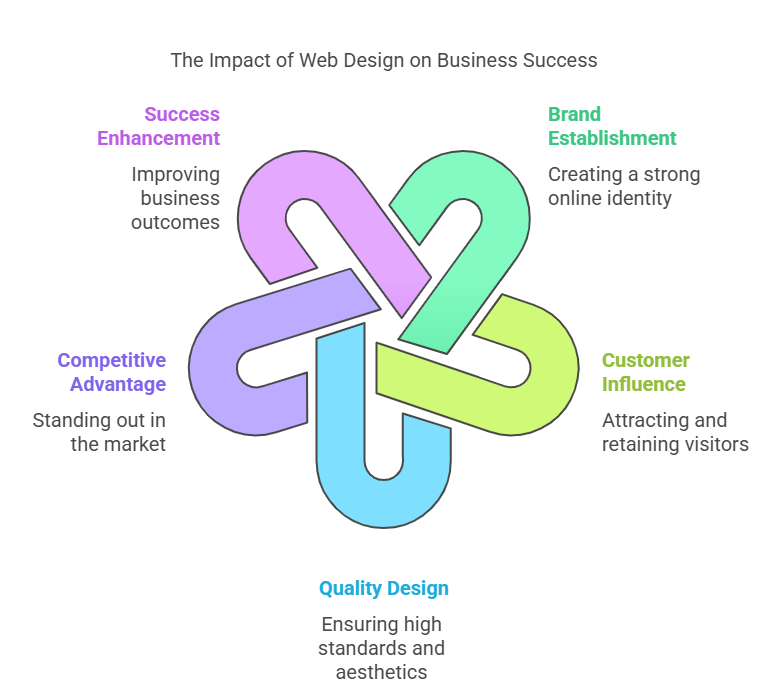
Why is Web Design Important for Businesses?
Understanding the Role of Web Design in User Experience
Web design is essential primarily because it directly impacts user experience. A user-friendly interface ensures visitors can navigate the site effortlessly, crucial for retaining their attention and encouraging them to explore further. Good web design incorporates intuitive navigation, clear calls-to-action, and a visually appealing layout, all contributing to a positive user experience. When a website is easy to use, it reduces frustration, increasing engagement and satisfaction. This underscores the importance of web design in creating a seamless and enjoyable interaction for users.
Moreover, a well-designed website caters to the diverse needs of its audience by being responsive and accessible. With the increasing use of mobile devices, ensuring that a website is mobile-compatible is no longer optional but necessary. A responsive design adjusts seamlessly to different screen sizes, providing an optimal viewing experience. Accessibility features, such as alternative text for images and keyboard-friendly navigation, are crucial in making a website inclusive for all users. These elements collectively enhance the user experience, making web design a vital aspect of a business’s digital strategy.
The Impact of Web Design on Conversion Rates
One of the key reasons why web design is important is its impact on conversion rates. A well-designed website can significantly influence a visitor’s decision to become a customer. Businesses can strategically place conversion elements like sign-up forms, contact buttons, and product showcases to guide users towards taking desired actions. The aesthetics and functionality of a website can either encourage or deter conversions. For instance, a cluttered or confusing layout can overwhelm users, while a clean and organized design can lead to higher conversion rates.
Additionally, web design elements such as colour schemes, typography, and visual hierarchy are crucial in guiding user behaviour and enhancing conversion rates. Colours can evoke emotions and influence purchasing decisions, while typography affects readability and the brand’s overall perception. A well-thought-out visual hierarchy directs users’ attention to key information, making it easier for them to make informed decisions. Businesses can create a more persuasive and effective online presence by optimizing these design aspects, increasing conversions.
How Web Design Affects a Brand’s Online Presence
The importance of web design extends beyond user experience and conversion rates, as it also significantly impacts a brand’s online presence. A well-designed website is a digital storefront that reflects the brand’s values, personality, and professionalism. Consistent branding elements such as logos, colour schemes, and messaging help establish a strong brand identity, making it easier for users to recognize and remember the business. This consistency across all digital platforms enhances the brand’s credibility and trustworthiness.
Furthermore, a good website design can set a business apart. In a crowded digital marketplace, a unique and visually appealing website can capture attention and leave a lasting impression on potential customers. By investing in custom web design, businesses can effectively differentiate themselves and communicate their unique value propositions. This strengthens the brand’s online presence and fosters customer loyalty and advocacy, ultimately contributing to long-term success.
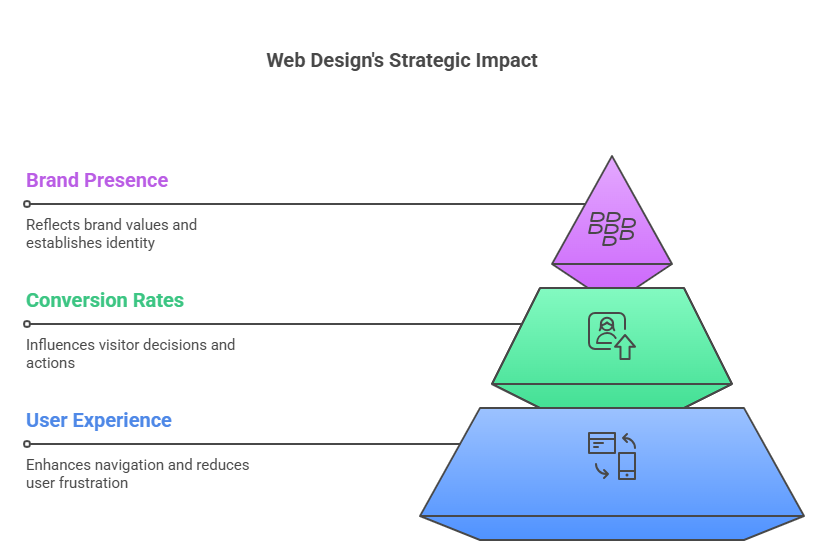
What Makes a Good Website?
The Key Web Design Elements to Consider
Creating a good website involves considering several key design elements that contribute to its effectiveness. Visual elements such as layout, colour schemes, and imagery are crucial in attracting and retaining users’ attention. A well-structured layout ensures that information is presented logically and intuitively, making it easy for users to find what they are looking for. The choice of colours should align with the brand’s identity and evoke the desired emotions in users, while high-quality imagery enhances the visual appeal and professionalism of the site.
In addition to visual elements, functionality is a critical aspect of good website design. A user-friendly interface with intuitive navigation allows users to explore the site effortlessly, improving their overall experience. Interactive features such as sliders, hover effects, and animations can enhance engagement and make the website more dynamic. Furthermore, incorporating clear and compelling calls-to-action encourages users to take specific actions, such as signing up for a newsletter or purchasing. By focusing on these key web design elements, businesses can create a website that looks good and performs effectively.
Ensuring Responsive and Mobile Compatibility
In today’s mobile-first world, ensuring a website is responsive and mobile-compatible is crucial for its success. A responsive design automatically adjusts the layout and content to fit different screen sizes, providing an optimal viewing experience on desktops, tablets, and smartphones. This flexibility is essential as more users access websites from mobile devices, and a non-responsive site can lead to a poor user experience and high bounce rates. Businesses can reach a wider audience and improve user satisfaction by prioritizing mobile compatibility.
Responsive design also significantly affects search engine optimization (SEO). Search engines like Google prioritize mobile-friendly websites in their rankings, meaning a responsive design can improve a site’s visibility and organic traffic. Additionally, a mobile-compatible website reduces the need for separate mobile and desktop versions, streamlining maintenance and ensuring consistency across all devices. By embracing responsive design, businesses can enhance user experience and SEO, ensuring their website remains competitive in the digital landscape.
Importance of Usability and Accessibility
Usability and accessibility are essential to good website design, ensuring that all users can interact with the site effectively and efficiently. Usability focuses on creating an intuitive and user-friendly interface that allows visitors to navigate the site easily. This involves clear labelling, logical information architecture, and straightforward navigation paths. A website that is easy to use reduces frustration and increases user satisfaction, encouraging repeat visits and engagement.
Accessibility, however, ensures that the website can be used by individuals with disabilities, providing equal access to information and functionality. This includes features like screen reader compatibility, keyboard navigation, and text alternatives for non-text content. By prioritizing accessibility, businesses can reach a broader audience and demonstrate their commitment to inclusivity. Moreover, accessibility is increasingly becoming a legal requirement, making it a critical aspect of web design. By focusing on usability and accessibility, businesses can create a more inclusive and user-friendly online presence.

How Does Website Design Influence SEO?
The Connection Between Web Design and SEO
Website design is pivotal in search engine optimization (SEO), affecting how search engines crawl and index a site. A well-structured website with clean code and logical navigation makes it easier for search engines to understand its content and relevance. Elements such as meta tags, alt text for images, and header tags contribute to SEO by providing context and keywords for search engines. By optimizing these aspects, businesses can improve their website’s visibility and ranking on search engine results pages.
Additionally, web design influences SEO through page load speed and mobile compatibility. Search engines prioritize fast-loading websites, as they provide a better user experience. A slow-loading site can lead to high bounce rates, negatively impacting SEO performance. Similarly, mobile-friendly design is crucial for SEO, as search engines favour websites offering a seamless experience across all devices. By aligning web design with SEO best practices, businesses can enhance their online visibility and attract organic traffic.
Optimizing Web Design for Search Engines
To optimize web design for search engines, businesses must focus on several key areas. First, ensuring the website is mobile-friendly is essential, as search engines prioritize mobile-compatible sites in their rankings. This involves using responsive design techniques that adapt the layout and content to different screen sizes. Additionally, optimizing page load speed is crucial, as search engines favour faster websites and provide a better user experience. Techniques such as image compression, browser caching, and minimizing HTTP requests can help improve load times.
Another critical aspect of optimizing web design for SEO is using relevant keywords and metadata. Incorporating keywords naturally into the website’s content, meta descriptions, and alt text helps search engines understand the site’s relevance to specific queries. Additionally, using descriptive and keyword-rich URLs can enhance SEO performance. By focusing on these optimization strategies, businesses can improve their website’s search engine ranking and attract more organic traffic, boosting their online presence and visibility.
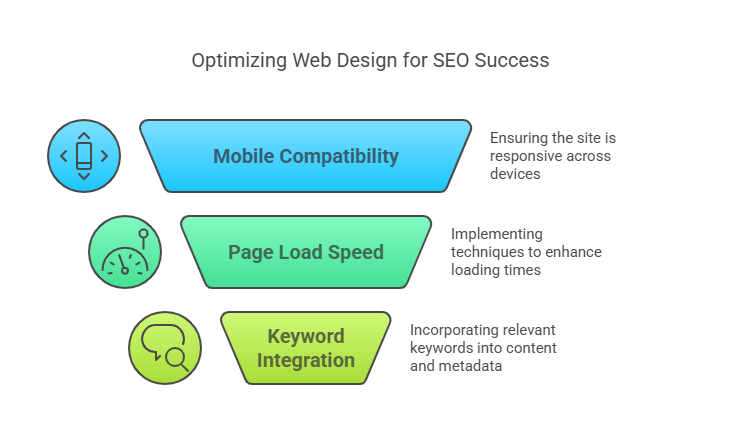
What Are the Important Elements of Web Design?
Essential Visual Elements in Web Design
Visual elements are a fundamental aspect of web design, as they significantly influence a user’s first impression and overall experience. Key visual elements include layout, colour schemes, imagery, and typography. A well-organized layout ensures that information is presented logically and intuitively, making it easy for users to navigate the site. The choice of colours should align with the brand’s identity and evoke the desired emotions in users, while high-quality imagery enhances the site’s visual appeal and professionalism.
Typography also plays a crucial role in web design, as it affects readability and the brand’s overall perception. Choosing the right fonts and font sizes can enhance the user experience by making content easily read and visually appealing. Consistency in typography across the site helps establish a cohesive and professional look. By focusing on these essential visual elements, businesses can create a website that looks good, effectively communicates their brand message, and engages users.
The Role of Typography in Website Design
Typography is vital to a website’s design, affecting aesthetics and functionality. The choice of fonts, sizes, and styles can significantly impact readability and user experience. A well-chosen typeface enhances the site’s visual appeal and reinforces the brand’s identity. Consistency in typography across the website ensures a cohesive look and feel, making it easier for users to navigate and consume content. Businesses can create a more engaging and user-friendly online presence by prioritizing typography.
In addition to aesthetics, typography also plays a role in accessibility and SEO. Using web-safe fonts and ensuring sufficient contrast between text and background improves readability for all users, including those with visual impairments. Properly using heading tags and alt text for images enhances SEO by providing context and keywords for search engines. By focusing on typography, businesses can create a website that is visually appealing, accessible, and optimized for search engines, ultimately enhancing their online presence and user experience.
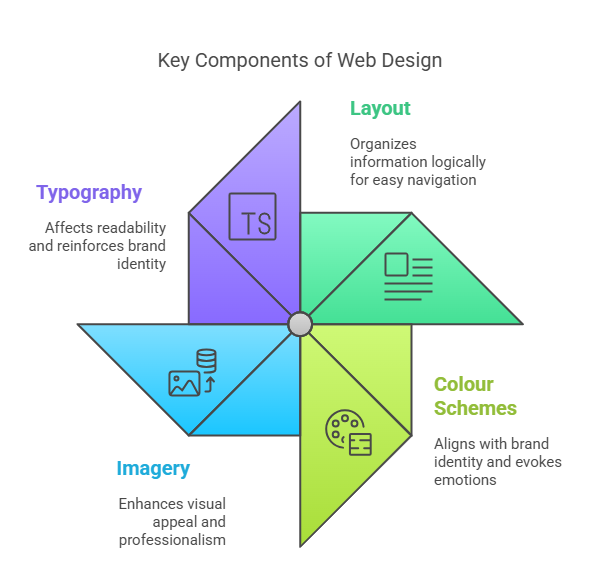
What Are the Best Practices in Web Development?
Following the Web Design Process
The web design process is crucial to creating a successful website, as it ensures that all elements are thoughtfully planned and executed. The process typically begins with research and planning, where businesses define their goals, target audience, and key features of the site. This stage involves creating wireframes and prototypes to visualize the layout and functionality of the website. By following a structured web design process, businesses can ensure that their website meets their objectives and provides a positive user experience.
Once the planning stage is complete, the design phase begins, where visual elements such as colour schemes, typography, and imagery are developed. This is followed by the development phase, where the website is built using coding languages like HTML, CSS, and JavaScript. Testing and quality assurance are essential steps in ensuring that the site functions correctly across different devices and browsers. By adhering to best practices in the web design process, businesses can create a visually appealing, functional, and user-friendly website.
Collaborating with a Web Design Agency
Collaborating with a web design agency can be a valuable investment for businesses seeking to create a professional and effective website. A web design agency brings expertise and experience, ensuring the website is designed and developed to meet industry standards and best practices. Agencies typically offer services, including custom web design, development, and digital marketing, providing a comprehensive solution for businesses looking to enhance their online presence.
Working with a web design agency also allows businesses to benefit from the latest trends and technologies in web design. Agencies stay up-to-date with industry developments and can provide insights and recommendations on optimizing the website for performance and user experience. Additionally, agencies often have a team of specialists, including web designers, developers, and digital marketers, who can collaborate to create a cohesive and effective online presence. By partnering with a web design agency, businesses can ensure their website is well-designed, functional, and aligned with their goals.
Understanding Web Design and Development
Understanding the relationship between web design and development is crucial for creating a successful website. Web design focuses on the visual and aesthetic aspects of the site, including layout, colour schemes, typography, and imagery. It involves creating a visually appealing, user-friendly interface that engages users and reflects the brand’s identity. On the other hand, web development involves the technical implementation of the design, using coding languages like HTML, CSS, and JavaScript to build the website’s structure and functionality.
Both web design and development are essential components of a good website, as they work together to ensure the site is visually appealing and functional. A solid development framework must support a well-designed website to ensure it performs effectively across different devices and browsers. By understanding the roles of web design and development, businesses can create a website that looks good and provides a seamless and engaging user experience. This holistic approach is key to achieving a successful online presence and meeting business objectives.
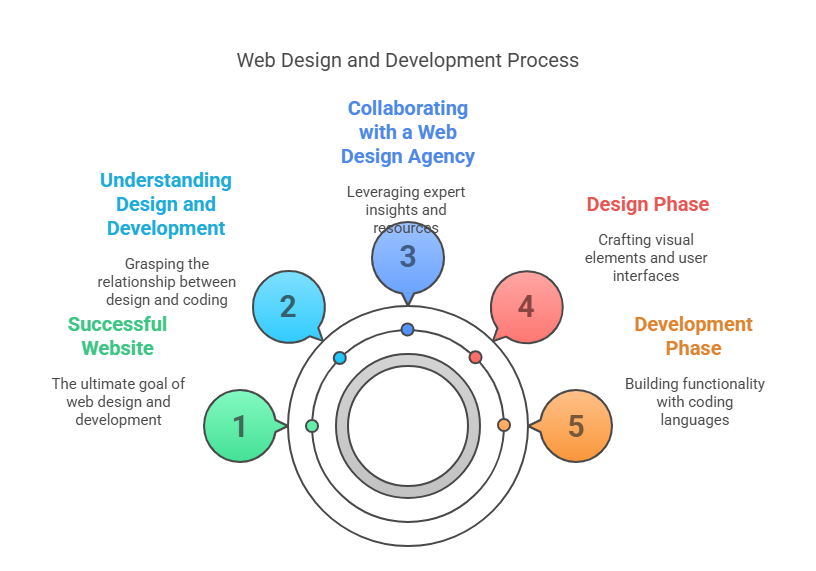
Frequently Asked Questions (FAQs)
Alright, let’s dive in! Web design is essential because it directly impacts how your audience perceives your brand’s online presence. A good website design can make a lasting first impression, helping to establish trust and encourage users to stay longer, leading to better conversion rates. Plus, it plays a crucial role in your SEO efforts, making it easier for search engines to crawl and index your site.
Great question! Some of the main web design elements you should focus on include typography, colour scheme, imagery, and layout. These elements work together to create a user-friendly and visually appealing website design. Don’t forget about responsive design to ensure your site looks great on all mobile devices, which is crucial for usability and SEO.
Web design plays a massive role in user experience. A well-designed website is easy to navigate, loads quickly, and provides the information users seek. This keeps visitors engaged and reduces bounce rates. A seamless user experience can lead to higher conversion rates and better customer satisfaction.
Absolutely! Web design and SEO go hand in hand. A good web design ensures your site is structured so search engines can easily crawl and index. Factors like fast loading times, responsive design, and proper use of headers and meta tags all contribute to better SEO performance.
In today’s mobile-first world, responsive web design is non-negotiable. It ensures that your website’s layout adapts to different screens.




